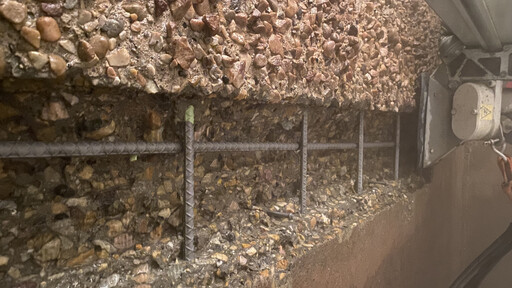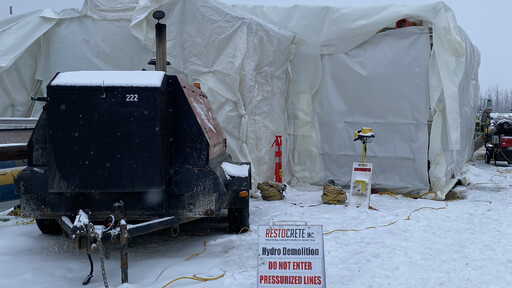Viable for a Variety of Jobs: Aquajet Ergo
Published: 4/3
Contractors know that hydrodemolition projects come in all shapes and sizes. Some jobsites provide a decent amount of workspace in more open areas, allowing contractors to utilize larger equipment. Other projects take place in confined spaces, such as building interiors, that limit the size of equipment. For these applications, contractors require a machine that still provides adequate power, but has the compactness to go where larger equipment can’t.
Tight spaces are where the Aquajet Ergo shines. Its compact size allows it to work in cramped spaces while providing Hydrodemolition performance four times more powerful than a hand lance. Its remote-control functionality also increases safety, allowing the operator to work out of harm’s way. With its safety and versatility offerings, the Ergo is a go-to for contractors with close-quarter projects. Here are three projects that called for a compact Hydrodemolition robot.
A Historic Worksite
Frank Capasso and Sons of Northford, Conn., used the Ergo to repair a historic New Haven parking garage. Designed by prominent Modernist architect Paul Rudolph, the 12-inch-thick concrete floor of the Temple Street Garage was deteriorating from decades of salt exposure. Removing more than 40,000-ft2 (3,716m2) of thick floor slab would be a difficult feat for jackhammers. There was also the potential effects of impact vibrations on the historic structure, and noise complaints from nearby Gateway Community College.
To complete the repair, company president Vinny Capasso paired the Ergo with the Aquajet Power Pack 250SM high-pressure pump, a compact unit that was small enough to be moved throughout each level of the parking garage, including the top floor. Capasso’s team found the compact Ergo had a feasible learning curve and used a manageable amount of water — approximately 500 gallons (1,893 liters) a day that they treated and released, with the slurry going to a recycling center. Because the repairs were spread throughout the multiple levels of the parking garage, setup and breakdown of the Ergo system was easier to move from one repair area to another. A two-person crew—an operator and a laborer to remove debris and manage the wastewater—removed 180 to 220 ft2 (16.7 to 20.4 m2) at a depth of 3 to 3.5 in (76.2 to 89 mm) a day. Frank Capasso and Sons had a year to complete the project but finished in just over 10 months. “I jackhammered a lot in my lifetime,” Capasso says. “To see the work done in this way is pretty amazing.”
Limited Access
A unique project occurred in the basement of an industrial building in Montreal, Quebec. The building required a new layout for tanks, each of which needed a drain line. The contractor tasked with the job needed to create trenches in the basement’s concrete to install new drainpipes. The building owner didn’t want jackhammers or saws to be used because they wanted to keep the rebar intact. The concrete slab couldn’t be damaged because of water pressure from the ground water under the building. Furthermore, the basement setting offered limited access that restricted larger equipment from entering.
Montreal-based Groupe MGC took on the project
“Based on the space we had to work in, the compactness of the Ergo was an advantage,” Groupe MGC president Carl Henri says. “We could have used larger equipment in the work area itself, but limited access made it impossible to get the equipment into the building. One of the main reasons we invested in the Ergo is for projects that require us to work in tighter spaces where we can’t bring larger machines.”
The crew removed 20 cubic meters of concrete at a depth of 24 in (610mm) for the challenging project. Groupe MGC completed the job in just over three weeks using a crew of four to six people. Handling wastewater was particularly challenging given the location of the job where only compact equipment could access the work area. The crew collected water and debris from the work zone with a vacuum truck and transferred it to a holding tank for treatment.
Subzero Setting
During the frigid winter in northern Alberta, a pulp and paper plant removed a pump from a below-grade chamber for maintenance. After pulling the pump, they discovered that the surrounding concrete was deteriorated to the point of having exposed rebar. The concrete walls were about 12 in (305mm) thick with around 4 in (101.6mm) of the concrete chewed away; and the ceilings were similarly deteriorated. Edmonton, Alberta concrete repair specialist Restocrete, Inc., needed an efficient Hydrodemolition machine that could be operated from a safe distance above the chamber, so they turned to the Aquajet Ergo. The environment presented multiple challenges, beginning with the area for removal. The pit with the damaged concrete was below the water table and a confined space at about 16 ft (4.9m) deep, making traditional removal methods difficult and potentially dangerous should something go wrong. However, thanks to the Ergo’s remote-control capabilities, the Restocrete crew could operate the equipment safely from above, with significant reduction of time in the pit for removal.
The weather presented another hurdle. Temperatures during the project got as low as -22° F (-42° C). The Restocrete crew constructed an insulated shed for the Ergo and Jetstream pump to reside in with heaters running throughout the project. The tent provided some protection from the elements but couldn’t be entirely sealed, allowing a freezing wind to flow through at times.
Visibility also became an issue as the temperature difference between the air in the pit and inside of hoarding produced a great deal of steam when 40,000 psi (2,758 bar) was used. This hindered visibility and forced the crew to halt work at various points to let the air clear and ensure operation in the pit was running smoothly.
At project end, Restocrete completed concrete removal and repair on three of the five chambers at the plant, taking out all deteriorated concrete, extending behind the rebar, at a depth of 4 to 6 in (101.6 to 152.4 mm). The Hydrodemolition portion took about a week. Then, they had to go back, form and pump the concrete, then coat it.
“Even with the timeline slightly drawn out due to pausing at points because of the steam, this project was significantly faster, leaving better quality surface profile and overall concrete condition with Hydrodemolition than what it would’ve been with jackhammering,” says Justin Downar, Restocrete’s commercial manager.
Whether it’s a historic parking garage, an industrial building or an underground pit, using an Ergo for Hydrodemolition provides an efficient, versatile solution for contractors. The heightened safety, remote-control operation in confined spaces and efficiency has made it an attractive replacement for traditional concrete removal and repair methods.








